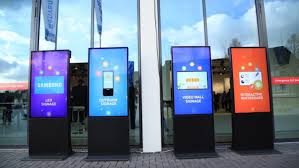
1.Intoduction to Outdoor Digital Signage
• Definition and Technology: Understanding what outdoor digital signage is and the technology behind it.
Outdoor digital signage represents a dynamic communication medium featuring digital displays that show advertisements, menus, information, or other messages. These signs utilize technologies such as LCD, LED, and projections to display content that can be easily updated and interacted with, offering more flexibility than traditional static billboards.
• Evolution of Outdoor Advertising: How advertising has transformed from traditional methods to digital approaches.
From painted billboards to neon signs, outdoor advertising has continuously evolved. Today, digital signage offers a modern twist, allowing advertisers to integrate motion graphics and change messages throughout the day effortlessly.
• Importance in the Modern Market: The role of digital signage in today’s advertising landscape.
In the fast-paced modern market, capturing attention quickly is crucial. Digital signage meets this need by enabling vivid, engaging displays that can adapt in real-time to changing audiences and conditions.
2. Enhanced Visibility and Attention
• High-Impact Visuals: Exploring how dynamic and bright displays capture attention.
These vibrant displays can stop passersby in their tracks. Whether it’s a bright, sunny day or a dark, rainy evening, the luminance and contrast of digital signs ensure your message stands out.
•24/7 Visibility: The benefits of constant exposure, regardless of time or weather.
Digital signs shine bright all day and night. Their ability to remain visible and eye-catching around the clock means your advertising works overtime, without additional costs.
• Adaptability to Environment: How signage can be optimized for different lighting conditions and locations.
Outdoor digital signage can adjust its brightness based on ambient lighting conditions ensuring maximum visibility and effectiveness from sunny days to dark nights.
3.Content Versatility and Update Ease
• Easy Content Updates: The simplicity of changing ad content in real time.
Updating content on digital signage is as simple as a few clicks. This means you can react to trends, context, or feedback much quicker than with traditional advertising methods.
• Variety of Media Formats: Using videos, GIFs, and slideshows to engage audiences.
The versatility to use different media formats keeps content fresh and engaging. Imagine using a captivating video or fun GIFs to draw attention and entertain potential customers.
• Scheduling Flexibility: How content can be scheduled for specific times to maximize impact.
Program your signage to display different content at different times of the day, targeting specific demographics or aligning with peak foot traffic times, thereby enhancing the effectiveness of campaigns.
4. Increased Engagement and Interaction
•Interactive Capabilities: Incorporating touchscreens and QR codes to enhance user engagement.
Imagine a billboard where you can interact via touchscreen or scan a QR code for a special offer. These interactive features convert traditional viewing into an engaging experience that can help forge deeper connections with the audience.
•Targeted Content: Tailoring messages to specific demographics at different times.
Digital signage allows for targeting particular audience segments at different times of the day — commuters in the morning or shoppers during weekends — making your advertising more relevance and personalized.
•Immediate Call to Action: Encouraging instant responses from viewers via interactive elements.
By integrating real-time calls to action — like scanning a QR code to get a discount — digital signage can directly influence consumer behavior and drive immediate engagement.
5.Cost Efectiveness and ROI
• Lower Long-Term Costs: Comparing the cost-efficiency of digital signages versus traditional billboards.
While the initial setup cost might be higher, the ease of changing digital content eliminates the repetitive costs of printing and posting new billboards, offering substantial savings over time.
• Durability and Maintenance: Analyzing the lifespan and upkeep of digital displays.
Digital signs are built to withstand harsh weather conditions and require minimal maintenance, making them a more durable option than traditional billboards.
• Analytics and Feedback: Utilizing built-in analytics to measure and optimize advertising effectiveness.
Digital signage systems can include cameras and sensors that provide data on who is viewing your ads and for how long, enabling you to analyze and optimize the effectiveness of different content.
6. Environmental Impact and Regulation
• Energy Consumption: Discussing the energy efficiency of modern digital signages.
Modern digital signages are increasingly incorporating eco-friendly technologies that lower energy consumption, making them more sustainable than traditional outdoor advertising methods.
• Regulatory Compliance: What businesses need to know about advertising laws and digital displays.
It’s important to understand local regulations regarding digital advertising to ensure compliance and avoid potential legal issues.
• Eco-Friendly Options: Advances in technology for greener digital signage solutions.
Advancements include solar-powered units and the use of recyclable materials, helping reduce the carbon footprint of outdoor digital advertising.
Conclusion
• Summary of Benefits: Reiterating the major advantages of outdoor digital signages.
Outdoor digital signage offers undeniable advantages in visibility, engagement, cost-effectiveness, and environmental impact, revolutionizing how businesses advertise in the public space.
• Future Prospects: How the technology might evolve and its future implications in advertising.
As technology advances, we can anticipate even smarter, more interactive digital signages that continue to push the boundaries of what outdoor advertising can achieve. The possibilities are as exciting as they are endless.
